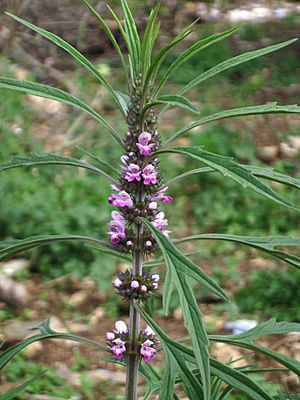Honeyweed facts for kids
Quick facts for kids Honeyweed |
|
|---|---|
 |
|
| Scientific classification | |
| Genus: |
Leonurus
|
| Species: |
sibiricus
|
Leonurus sibiricus, often called honeyweed or Siberian motherwort, is a plant that grows from the ground. It is originally from places like China, Mongolia, and Siberia. This plant has special flower clusters that grow in circles around its stem. You can now find it growing naturally in many other parts of the world, including North, Central, and South America.
What the Plant Looks Like
Leonurus sibiricus is a plant that lives for one or two years. It has straight stems that can grow from about 8 inches (20 cm) to 31 inches (80 cm) tall. The leaves near the bottom of the plant have long stems and are shaped like a heart. These leaves have jagged edges and are deeply cut into many parts.
Usually, one or a few flowering stems grow from short roots. The leaves on the lower part of the stem fall off as the plant starts to bloom. The stems of the leaves in the middle of the plant are about 2 inches (5 cm) long.
The flowers grow in many clusters called verticillasters. These clusters form circles around the top half or more of the stem. The flowers sit directly on the stem without their own little stalks. They have cup-shaped green parts, called calices, that are about 0.3 inches (8 mm) long. The flower petals, called the corolla, can be white, reddish, or purple-red. The top part of the flower is longer than the bottom part.
After the plant finishes flowering, it makes many small, brown, oblong seeds called nutlets. The plant usually blooms from July until late September. However, if the weather is warm enough, it can flower all year long.
In its natural home, this plant likes to grow in rocky or sandy grasslands, or in pine forests.
Special Plant Chemicals
Plants often contain special natural chemicals. Leonurus sibiricus has chemicals called alkaloids. These are compounds that plants make naturally. One of these special chemicals is called Leonurine.
See also
 In Spanish: Leonurus sibiricus para niños
In Spanish: Leonurus sibiricus para niños


